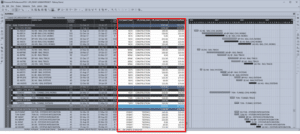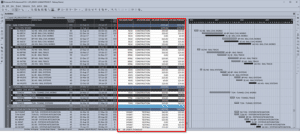Once we show clients and owners a Location Based Schedule, their understanding of the project increases, and decision making becomes quickly informed which creates a more successful project. I was able to learn the software in less than 3 hours, had a schedule completed in less than a day. The clients were impressed within hours of sending the chart pdf by email.
How did you find out about turbo-chart?
As we were creating a baseline schedule for a large civil project in the Los Angeles region we desired to supplement our P6 schedule with a Location Based Schedule to clearly demonstrate the project plan on one sheet of paper for the owner.
Prior to Turbo-Chart, I started off by using a program from Trimble named Tilos to show our schedule graphically based on our Primavera P6 CPM schedule. When using Tilos, I would struggle with importing the schedule from P6 to get the project onto one page and make it legible with all the details needed to make the schedule useful
A fellow scheduler that was part of the JV team demonstrated how easy Turbo-Chart is to use and how it will synchronize with a P6 database with one click. The best part about the software was we could fit the 20-mile project onto one sheet with very little effort and make it legible for the team.
What is your experience in using these kinds of charts?
Location Based Schedules have been in the industry for many years, but as for myself I have been working with educating myself on Location Based Scheduling for over 2 years now on how they can make a project more successful.
Over the past 5 months of using Turbo-Chart I have seen first-hand the more educated decisions that have come directly from using a Location Based Schedule paired with a CPM schedule.
Which projects have you used turbo-chart on?
I purchased Turbo-Chart less than 5 months ago and have used Turbo-Chart for three projects throughout the United States. Project One and Project Two consist of constructing a baseline schedule for complex and heavy rail projects both in Florida and Los Angeles County, California.
The third project was to clearly demonstrate how project delays in a passenger rail project in Oklahoma have made our client work out of sequence and the client has been mitigating the delays for months to continue progress through the project.
How do you and other stakeholders value the time location charts produced by turbo-chart?
I use Turbo-Chart as one of our value-added services in our claims and scheduling consulting portfolio. We found that people can wrap their heads around a chart showing both location and time vs just time as a Gantt chart will show. An additional hurdle we found is that without an experienced scheduler behind the wheel driving, the CPM scheduling software is difficult to correlate time and location for major components of the project on one sheet of paper. Turbo-Chart equips schedulers with a technology that fills this gap.
We have seen that once we show clients and owners a Location Based Schedule, their understanding of the project increases, and decision making becomes quickly informed which creates a more successful project.
Before turbo-chart, how would you have produced this kind of chart?
Before Turbo-Chart all I knew personally was to use Tilos for linear based scheduling or in excel. This was only performed if a client specifically requests for the software or a location base schedule. I did not provide location based scheduling services as a value-added service becuase Tilos is so labor intensive as a scheduler and we could not justify the cost of the software or overhead costs to both the client or internally as a company.
What is the source of project data?
We use Microsoft Project and Primavera P6 standalone databases for internal work and when on a client’s jobsite we typically use Citrix type environments for a project source.
How often are you using turbo-chart?
We now use Turbo-Chart as a value-added service to our clients for their projects through the United States. Location base schedules such as what Turbo-Chart produces can easily point out risks and conflicts in the schedule based on location and time or show where improvements can be made increasing production rates or sequencing in order to save both time and money on a project.
We continue to see the value in being able to clearly show clients and owners their project CPM schedule without interpreting Gantt Charts.
How do you find using turbo-chart?
After learning Tilos software for 3-4 months and becoming frustrated with how overly complex the software is, the inability to sync with Primavera P6, the complex calculations it was performing in the background, and I was unable to fit the project onto one page when printing to either ledger or ANSI D drove me to work many un-billable hours to try to get a product to the client that I was still not satisfied with the results. Not to mention the costs of the Tilos software was not justified for the frustration levels I was having. I was able to learn the software in less than 3 hours, had a schedule completed in less than a day. The clients were impressed within hours of sending the chart pdf by email.
Would you recommend turbo-chart to others?
I have been recommending Turbo-Chart software to co-workers and fellow project controls professionals since I was recommended the software myself.
Project controls professionals benefit from using a location base schedule (primarily heavy civil projects) to clearly see how improvements can be made by increasing production rates or sequencing in order to save both time and money on a project. I consistently highlight to those I talk to:
An employee does not need 20 hours of training to use the software, the software has the ability to sync with scheduling databases in one click, can easily print the entire project onto one page with very minimal page layout settings, and a professional looking chart is produced when completed
Does turbo-chart have a ‘killer’ feature?
The best feature we like is the ability to sync Turbo-Chart with almost any scheduling database out there.
No more importing and exporting and making sure the process is done correctly, codes are carried over, version of exporting was correct, columns lined up correctly. With one click we can bring in new data from our CPM schedule and visualize the instant impacts we have made to a schedule. In both working on a scheduling project in the office or at a work session we typically run Turbo-Chart on one screen while on our second screen we are actively scheduling in Primavera P6
The smooth and effortless synchronization allows us instantly to demonstrate to a client the changes to a schedule in order to be more productive in front in “C” level meetings



